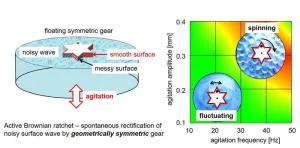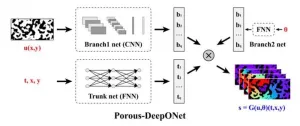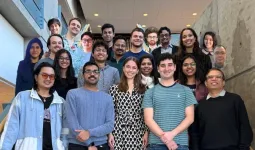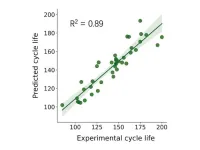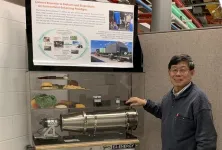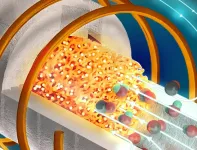(Press-News.org)
The ratchet mechanism is a fascinating energy-conversion system that converts disorderly or random motion into orderly, directed movement through a process known as spontaneous rectification. It is a critical component of mechanical systems, typically consisting of a gear and a pawl, which restricts the movement of the gear in one direction. In biological systems, the concept of a Brownian ratchet has been proposed to help understand the mechanism of molecular motors, where chemical reactions rectify the random thermal motion of molecules.
According to the second law of thermodynamics, uniform thermal fluctuations cannot spontaneously generate regular motion. Practical Brownian ratchets therefore require nonequilibrium fluctuations to function. Physiological chemical reactions in biological systems modulate thermal motion and are known to generate nonthermal fluctuations, which may be crucial for the ratchet mechanism. Moreover, identifying the types of nonequilibrium noisy motions that can be rectified by a ratchet mechanism is an intriguing and fundamental question in science, facilitating the development of novel energy-harvesting technologies. The Feynman–Smoluchowski ratchet is a classic example of an active Brownian ratchet, which has led to numerous ratchet motor studies. In most of these studies, the ratchet mechanism involves using a geometrically asymmetric ratchet to rectify nonthermal fluctuations derived from mechanical vibrations.
In a breakthrough, a team of researchers from the Department of Chemical Engineering and Materials Science, Doshisha University, led by a Ph.D. student Miku Hatatani along with Associate Professor Yamamoto Daigo and Professor Akihisa Shioi, developed a novel ratchet mechanism based on the asymmetry of surface wettability using a geometrically symmetric gear. “We realized a new model of an active Brownian ratchet motor that utilizes the surface-energy profile for the ratchet mechanism. This is quite different from conventional geometrically asymmetric ratchets and is closer to the biological one,” explains Hatatani. Their study was published in the journal Scientific Reports on July 18, 2024.
The innovative ratchet mechanism developed by the team involves a geometrically symmetric star-shaped gear made of acrylonitrile butadiene styrene (ABS) resin, with six triangular teeth. Parafilm is attached alternatively to the right side of each tooth, as viewed from the front face of the gear, resulting in a difference in surface wettability between the two faces of the teeth. The gear was tested by placing it in a water-filled petri dish, with its front facing a camera mounted on top of the dish. The gear was fixed with a push pin through a drilled hole in its center. The petri dish was placed on a vibrating disk that oscillated vertically at a pre-determined frequency, producing random fluctuations in water.
The gear with the parafilm demonstrated a one-way spin in the waterbed with vertical oscillations in a restricted range of frequency and amplitude. In contrast, the gear without the parafilm did not exhibit a one-way spin for any frequency or amplitude. The one-way spin for the parafilm gear was determined by the chirality of the gear, meaning that the spinning direction was opposite when viewed from different faces. It exhibited a clockwise spin direction when viewed from the front face, and vice versa. Interestingly, the gear showed fluctuations in both directions at shorter timescales but at longer timescales, it showed a one-way spin.
The researchers investigated the mechanism of this innovative ratchet motor and found that its unique motion is generated by a stochastic process with a biased driving force. This biased driving force was produced by the difference in interactions of the water waves, or surface wettability, between the highly smooth parafilm face and the relatively rough non-parafilm face of the gear teeth.
Highlighting the potential of this study, Hatatani remarks, “Considering that a molecular ratchet works on an asymmetric potential with cyclic variation, our system may provide a breakthrough in generating a new ratchet motor design. We believe that it can lead to the development of energy-harvesting technologies that can, for example, enable directed transport from vibrational noise and a micrometer-sized motor, acting in a microfluidic device.”
Looking ahead, she optimistically concludes, “We hope that our work can inspire future studies that will ultimately lead to the discovery of the missing link between science and technology for realizing real Brownian ratchets and consequently, lead to novel energy-harvesting technologies.”
About Miku Hatatani from Doshisha University, Japan
Miku Hatatani is currently a Ph.D. student in the Department of Chemical Engineering and Materials Science at the Graduate School of Doshisha University. She is also a member of the Laboratory of Molecular Chemical Engineering at Doshisha University. Her research interests include biological ratchet motors, Brownian ratchets, and a broad interest in nonequilibrium phenomena and nonlinear science.
Funding information
This research was funded by Japanese Society for the Promotion of Science (JSPS) to A.S.; (KAKENHI grant number JP22K03560) and was supported by JST, the establishment of university fellowships towards the creation of science technology innovation, and JST SPRING to M.H.; Grant Number JPMJFS2145 and JPMJSP2129.
Media contact:
Organization for Research Initiatives & Development
Doshisha University
Kyotanabe, Kyoto 610-0394, JAPAN
E-mail: jt-ura@mail.doshisha.ac.jp
END
Porous media play a critical role in various industrial fields due to their complex pore networks and considerable specific surface areas. The transport and reaction phenomena within porous media are key factors influencing fundamental parameters such as energy storage efficiency, catalytic performance, and adsorption rates. To accurately describe these complex transport and reaction processes, solving parameterized partial differential equations (PDEs) is necessary. However, due to the complex structure of porous media, traditional methods, such as the finite element method ...
ROCKVILLE, Md. – August 19, 2024 – The Association for Molecular Pathology (AMP), the premier global molecular diagnostic professional society, and world-renowned pathologist Michael Laposata, MD, PhD, today announced the filing of a lawsuit challenging the recent U.S. Food and Drug Administration (FDA) Rule that regulates laboratory developed test (LDT) procedures as medical devices under the Federal Food, Drug, and Cosmetic Act. The lawsuit was filed in the U.S. District Court for the Southern District of Texas against the FDA; Robert M. Califf, MD, in his official capacity as Commissioner of Food and Drugs; the U.S. Department of Health ...
Nylon, Teflon, Kevlar. These are just a few familiar polymers — large-molecule chemical compounds — that have changed the world. From Teflon-coated frying pans to 3D printing, polymers are vital to creating the systems that make the world function better.
Finding the next groundbreaking polymer is always a challenge, but now Georgia Tech researchers are using artificial intelligence (AI) to shape and transform the future of the field. Rampi Ramprasad’s group develops and adapts ...
LA JOLLA (August 14, 2024)—Professor Rusty Gage has been awarded the 2024 J. Allyn Taylor International Prize in Medicine by the Schulich School of Medicine & Dentistry and the Robarts Research Institute at Western University. One of the most prestigious medical research awards in Canada, the Taylor Prize recognizes scientists for transformative, career-defining work in basic sciences, translational research, and medical innovations.
This year’s prize specifically honors a research leader in aging-related medical science and research—a long-term focus of Gage and his lab. Gage will receive $50,000 and be celebrated at a Robarts Research ...
We know that quality sleep is as essential to survival as food and water. Yet, despite spending a third of our lives in slumber, it largely remains a scientific mystery.
Not that experts haven’t tried.
Sleep analysis, also known as polysomnography, is used to diagnose sleep disorders by recording multiple types of data, including brain (electroencephalogram or EEG) and heart (electrocardiogram or ECG). Typically, patients are hooked up to dozens of sensors and wires in a clinic, tracking brain, ...
1. NIMS and SoftBank Corp. have jointly developed a model capable of predicting the cycle lives of high-energy-density lithium-metal batteries by applying machine learning methods to battery performance data. The model proved able to accurately estimate batteries’ longevity by analyzing their charge, discharge and voltage relaxation process data without relying on any assumption about specific battery degradation mechanisms. The technique is expected to be useful in improving the safety and reliability of devices powered by lithium-metal batteries.
2. Lithium-metal ...
Natasha Sheybani, assistant professor of biomedical engineering at the University of Virginia School of Engineering, will collaborate with researchers at Children’s National Hospital to study the combination of two therapies for pediatric brain cancer.
High-risk brain tumors in children often don’t respond well to existing chemotherapy and radiation treatments, but Sheybani and her collaborators hope their fusion of therapies will offer a better option.
Over the two-year project, researchers ...
URBANA, Ill. – As the world faces the challenges of mitigating climate change and providing resources for a growing population, there is increasing focus on developing circular economies for sustainable production. But to evaluate strategies and impacts, it is necessary to have reliable metrics. Researchers at the University of Illinois Urbana-Champaign have developed a Circularity Index that provides a comprehensive method to quantify circularity in bioeconomic systems. In a new paper, they outline the method and apply it to two case studies – a corn/soybean farming operation and the entire U.S. food and agriculture system.
“The ...
Not all forest fires have devastating effects. Low- and moderate-severity forest wildfires can reduce the intensity of future conflagrations for as long as 20 years in certain climates, according to new research by the University of California, Davis.
The extent of reduced severity of these second fires, or reburns, and the duration of the moderating effect, varies by climate, forest type and other factors. But initial fires continue to mitigate future severity even during extreme weather, such as wind, high temperatures and drought, research published in the journal Ecological ...
Currently, industrial processes in the U.S. account for approximately a third of the country’s carbon dioxide emissions – even more than the annual emissions from passenger vehicles, trucks, and airplanes combined. Decarbonizing this sector is a challenging but vital step in mitigating impacts on our future climate.
Researchers at Stanford Engineering have designed and demonstrated a new type of thermochemical reactor that is capable of generating the immense amounts of heat required for many industrial processes using electricity instead of burning fossil fuels. The design, published Aug. ...
